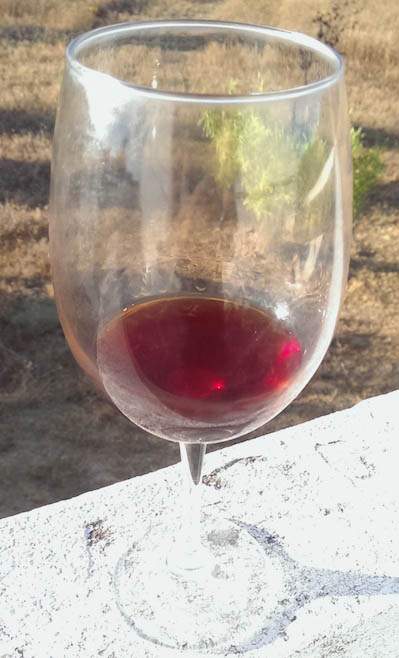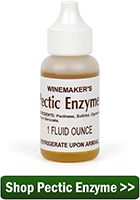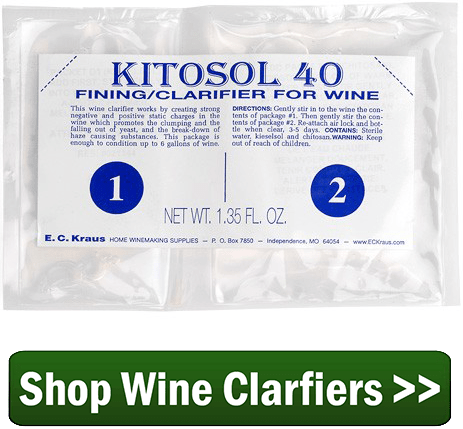 I made 5 gallons of pear wine from fresh pears and added a half gallon of citrus pomegranate from concentrate which was cloudy thus my wine is cloudy. I added Kitosol 40 after second racking and it partially cleared the wine. Can I add more Kitosol or this is as clear as it will get?
I made 5 gallons of pear wine from fresh pears and added a half gallon of citrus pomegranate from concentrate which was cloudy thus my wine is cloudy. I added Kitosol 40 after second racking and it partially cleared the wine. Can I add more Kitosol or this is as clear as it will get?
Name: Mary
State: Indiana
—–
Hello Mary,
Sounds like you might have a problem, Mary. Let’s see what we can do to help you out.
The reason pomegranate juice is cloudy is because it has an abundance of pectin in it. Pectin is not a particle that clears out with fining agents such as Kitosol 40 or Bentonite. It is something that is organically bonded to the wine. It’s not a particle; it’s actually part of the juice. This is know as a pectin haze.
When a wine fermentation occurs the wine yeast produce, among other things, pectic enzymes. During the fermentation the pectic enzymes break-down the pectin that may be in the wine must causing the juice to become clear. The activity of the fermentation itself, helps to energize this organic process. This is why it is possible make a clear pomegranate wine. That’s why a peach wine can start out cloudy and end up clear.
Most fruit wine recipes will call for additional pectic enzyme to be added on top of what the wine yeast will produce, as well. This helps to insure that you have a wine that is clear of a pectin haze. If you take a look at another blog post, “Why Do Wine Recipes Call For Pectic Enzyme“, you can read a little more about pectic enzyme and what it does.
In your case, you added pomegranate juice to the pear wine after the fermentation was complete, so you do not have any fermentation activity to help the pectic enzymes along in clearing up the pectin haze in your wine. This means you need to boost the pectic enzyme level in the wine. It also means you will need to be patient. It may take some time for your pear wine to become clear, if it’s able to clear at all.
Here’s what you can do. If you did not add pectic enzyme to the wine originally, then add two times the dosage recommend on the container the pectic enzymes comes in. If you added a dose of pectic enzyme to the wine already, than add another full dose. Be sure to blend it in completely. It may take some time for the wine to clear, months even. And even at that, there is a possibility that the pectic enzyme many not be able to clear up the pectin haze at all, since it is without the energy of an active fermentation.
Beyond this, you can add another pack of Kitosol 40. It may clear up your wine even more by dropping out yeast particles and other proteins that may still be lingering in the wine, but when it comes to the last bit of clearing, it is going to be up to the pectic enzyme to do the job.
In a worst case scenario, the pectin that is making the wine cloudy does not affect the wine’s flavor in any way. A pectin haze only affects the wine visually. So at a bare minimum you should have just as good of wine as ever that you can enjoy taste-wise.
Mary, I hope this information helps you out and you end up with a perfect clear pear/pomegranate wine.
Happy Winemaking,
Ed Kraus
—–
Ed Kraus is a 3rd generation home brewer/winemaker and has been an owner of E. C. Kraus since 1999. He has been helping individuals make better wine and beer for over 25 years.

Is that why my pineapple wine took so long to clear?
We did 2 5 gallon batches of pear wine in September. They were cloudy, so I added gelatin. This cleared out most of the haziness. I bottled the first batch although it was a bit hazy, but still delicious, and it is settling in the bottles somewhat. The second batch, I added Sparkaloid, and it is beautiful. It looks like pale whiskey. Hope this helps. Our pear trees are loaded again this year.
i’ve made pear wine for the last 2 years, i like it very much, but would like it a touch sweeter. i used bentonite, followed by sparkaloide and the wine is brilliant. if yours is on the sweeter side, would like to try a different receipe if you are willing to share it. thanks
Levergne, it could have been, but while pineapple has pectin, it is not nearly as severe as pomegranates. More than likely it was a slight fermentation continuing on.
I live in the Philippines and use Pommegranate all the time, i ad it to many other wines for a variety of reasons. If used sparingly, it never is cloudy, but I always use yeast nutrient. Mike’s problem is that he put too much concentrate it his 5 gallons of pear wine, also I sussect the pear juice has starch, maybe he has a starch haze. I have a gallon of pommegranate fermenting right now and it’s almost 2 months along and quite clear, but even though it contains no other juice, I only used a pint of fresh pommegranate fruit to make 4 liters of wine, I run this fruit through the blender for half a minute to break it up, but not long enough th break the seeds. The concentrate that Mike is using may be much stronger than the real fruit, and the real fruit is quite strong. The flavor of pure pommegranate wine is hard to beat, and by pure, I mean no other juice. I never use more than 1 quart of fruit juice when making a gallon of wine, the rest is water (pure water, not faucett water, I use rain water, but RO or distilled water will be ok also).
I have never made pear wine, how is it?
sincerely,
William McDaniel
Siquijor, Philippines
Hi William,
Your Pomegranate Wine sounds very ravishing. Do you add any sugar or not? If “yes” would you mind telling me the amount of sugar you add in a gallon?
if anyone can help me based on experience that will be great.
have you used 5,4,3,2,1 micron filters before?
from 5 to 1 which one removes the hazing we all get from the beginning of the wine?
i want to be able to see through the wine but i also dont want to filter too much
just enough that you can see through the wine